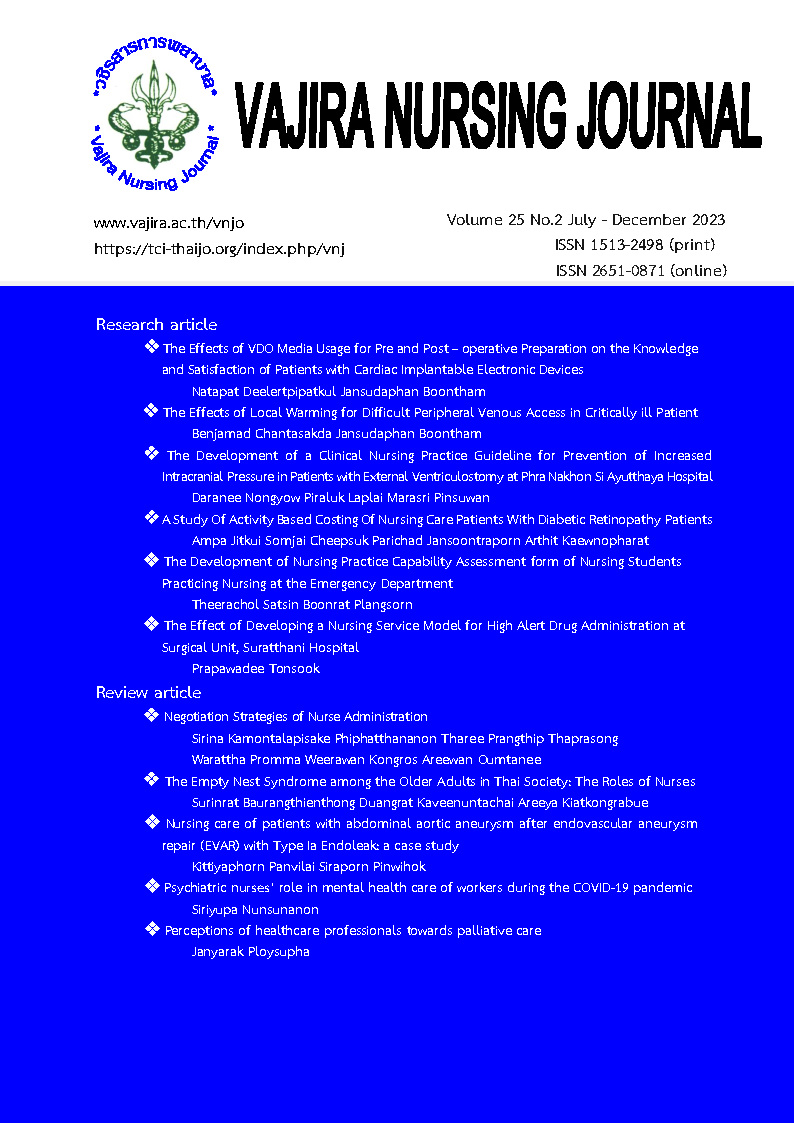การพัฒนาแบบประเมินความสามารถด้านปฏิบัติการพยาบาล ของนักศึกษาพยาบาลขึ้นฝึกปฏิบัติการพยาบาล ณ หน่วยอุบัติเหตุและฉุกเฉิน
Main Article Content
บทคัดย่อ
การวิจัยครั้งนี้เพื่อพัฒนาและตรวจสอบคุณภาพของแบบประเมินความสามารถด้านปฏิบัติการพยาบาลของนักศึกษาพยาบาลขึ้นฝึกปฏิบัติการพยาบาล ณ หน่วยอุบัติเหตุและฉุกเฉิน กลุ่มตัวอย่างที่ใช้ในการวิจัย ได้แก่ นักศึกษาพยาบาลชั้นปีที่ 3 คณะพยาบาลศาสตร์ มหาวิทยาลัยสวนดุสิต ในภาคเรียนที่ 1 ปีการศึกษา 2566 จำนวน 30 คน ซึ่งได้มาโดยการสุ่มแบบง่าย ด้วยวิธีการจับสลาก และอาจารย์นิเทศ จำนวน 3 คน การเลือกกลุ่มตัวอย่างแบบเจาะจง เครื่องมือที่ใช้ในงานวิจัย ได้แก่ แบบประเมินความสามารถด้านปฏิบัติการพยาบาลของนักศึกษาพยาบาลขึ้นฝึกปฏิบัติการพยาบาล ณ หน่วยอุบัติเหตุและฉุกเฉิน และแบบประเด็นคำถามการสนทนากลุ่ม โดยใช้การสนทนากลุ่มแบบออนไลน์ ผ่านโปรแกรมไมโครซอฟท์ทีมการวิเคราะห์ข้อมูล โดยการวิเคราะห์ค่าความถี่ ค่าร้อยละ เพื่อหาค่าดัชนีความสอดคล้องใช้การวิเคราะห์ค่าสัมประสิทธ์แอลฟาของครอนบาคเพื่อวิเคราะห์ความสอดคล้องระหว่างผู้ประเมิน
ผลการศึกษา พบว่า ดัชนีความสอดคล้องระหว่างองค์ประกอบความสามารถและพฤติกรรมบ่งชี้ระดับคุณภาพจากผลการตัดสินของผู้เชี่ยวชาญ ด้านความสามารถของการประเมินอาการในภาวะฉุกเฉิน ด้านทักษะปฏิบัติการพยาบาล ด้านการติดต่อสื่อสาร ด้านจริยธรรมและกฎหมาย และด้านบุคลิกภาพและการพัฒนาตนเองหาค่าดัชนีความสอดคล้อง เท่ากับ 1, 0.98, 0.67, 0.80 และ 1 ตามลำดับ และค่าสัมประสิทธ์แอลฟาของครอนบาค เท่ากับ 0.80, 0.82, 0.65, 0.69 และ 0.87 ตามลำดับ
Article Details

อนุญาตภายใต้เงื่อนไข Creative Commons Attribution-NonCommercial-NoDerivatives 4.0 International License.
เนื้อหาและข้อมูลในบทความที่ลงตีพิมพ์ในวชิรสารการพยาบาลถือเป็นข้อคิดเห็นและความรับผิดชอบของผู้เขียนบทความโดยตรง ซึ่งกองบรรณาธิการไม่จำเป็นต้องเห็นด้วย หรือร่วมรับผิดชอบใด ๆ ทั้งสิ้น
บทความ ข้อมูล เนื้อหา รูปภาพ ฯลฯ ที่ได้รับการตีพิมพ์ในวชิรสารการพยาบาล ถือเป็นลิขสิทธิ์ของวชิรสารการพยาบาล หากบุคคลใดหรือหน่วยงานใดต้องการนำทั้งหมดหรือส่วนหนึ่งส่วนใดไปเผยแพร่ต่อหรือเพื่อกระทำการใด ๆ จะต้องได้รับอนุญาตเป็นลายลักอักษรจากวชิรสารการพยาบาลก่อนเท่านั้น
เอกสารอ้างอิง
Praveda K. Teaching clinical practice according to the expectations of nursing students. Journal of Nurses Association of Thailand Northern Region. 2564; 27(1): 17-28. (in Thai)
Somkit R. Organizing teaching and learning in the clinic. Bangkok: Chulalongkorn University Press. 2007. (in Thai)
Satsin T., and Wongwiseskul S. Lessons Learn from Online Teaching: Challenges for Teacher under COVID - 19 Situations. J Royal Thai Army Nurses. 2021; 22(1): 1-9. (in Thai)
Son, Young-Ju, Insook Lee, and Chang-Seung Park. A Study of competence of nursing students in Emergency Nursing Core Skills. Journal of Problem-Based Learning. 2016; 3(1): 15-22.
AlShibi, Ahmad N., and Ayman M. Hamdan-Mansour. "Nurses' knowledge and skills to manage patients with psychological distress in emergency departments." The Open Nursing Journal . 2020; 4(1).
Boonjai S. The methodology in nursing research. Bangkok. U and I intermedia; 2010. (in Thai)
Wipatsaya K., Bunpitcha C. and Kulwadee A. Development of a Registered Nurse Competency Framework, Emergency Department, Buddhachinaraj Phitsanulok Hospital. Nursing Journal CMU. 2565; 49(1): 138-147. (in Thai)
National Institute of Emergency Medicine. (2015). Guidelines to follow the rules, criteria and procedures to sort and prioritize emergency care at the emergency room, according to the emergency medical board. Nonthaburi: Author. (in Thai)
Malee K. and Kittiporn N. Guideline for Developing Quality and Safety in Caring for Patients with Accident and Emergency. EAU HERITAGE JOURNAL SCIENCE AND TECHNOLOGY. 2565; 11(3): 30-42. (in Thai)
Monrudee P., Yothaka Phakaphong & Peraya Sutheelangkun. Role and Competencies of Emergency Nurses in Triage Assessment for Patients in Emergencies. EAU HERITAGE JOURNAL SCIENCE AND TECHNOLOGY. 2563; 14(3): 60-71. (in Thai)
Rawiwan Y. and Suntrara T. A Development of the Essential Emergency Department Nurse' Competency in the Trauma Center Hospital Level 1-2. J Royal Thai Army Nurses. 2013; 11(2): 53-60. (in Thai)
Sirichai K, Classical Testing Theory. 6thedition. Bangkok: Chulalongkorn University Press. 2009: 266-268. (in Thai)


